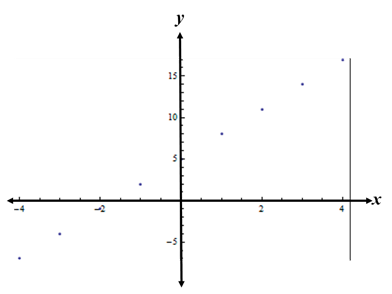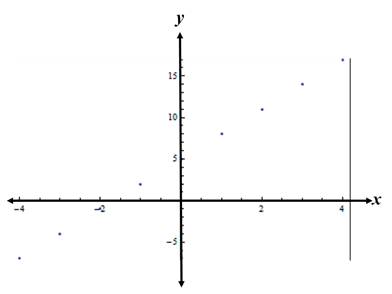
To represent:table of values and graph the set of ordered pairs of the equations
Answer to Problem 8CFU
| x | y |
| -4 | -7 |
| -3 | -4 |
| -2 | -1 |
| -1 | 2 |
| 0 | 5 |
| 1 | 8 |
| 2 | 11 |
| 3 | 14 |
| 4 | 17 |

Explanation of Solution
Given information: The equations are as follows:
Calculation:
Substitute the value of x from -4 to 4 in equation (1) to get value of y as shown below.
| x | y |
| -4 | -7 |
| -3 | -4 |
| -2 | -1 |
| -1 | 2 |
| 0 | 5 |
| 1 | 8 |
| 2 | 11 |
| 3 | 14 |
| 4 | 17 |
From the table, the set of ordered pairs of the relation in (x,y) is as follows:
Plot these values on the graph as shown below.

Since we are dealing with the integer in the domain, hence the coordinates are not connected in a straight line.
Chapter 1 Solutions
Advanced Mathematical Concepts: Precalculus with Applications, Student Edition
Additional Math Textbook Solutions
Elementary Statistics: Picturing the World (7th Edition)
Intro Stats, Books a la Carte Edition (5th Edition)
Calculus: Early Transcendentals (2nd Edition)
A Problem Solving Approach To Mathematics For Elementary School Teachers (13th Edition)
Thinking Mathematically (6th Edition)
Calculus: Early Transcendentals (2nd Edition)
- Write an integral that is approximated by the following Riemann sum. Substitute a into the Riemann sum below where a is the last non-zero digit of your banner ID. You do not need to evaluate the integral. 2000 (10 1 ((10-a) +0.001) (0.001)arrow_forwardEach of the following statements is an attempt to show that a given series is convergent or divergent using the Comparison Test (NOT the Limit Comparison Test.) For each statement, enter C (for "correct") if the argument is valid, or enter | (for "incorrect") if any part of the argument is flawed. (Note: if the conclusion is true but the argument that led to it was wrong, you must enter I.) ☐ 1. For all n > 1, seriesΣ In(n) In(n) converges. 2, 1, arctan(n) the series arctan(n) n³ ☐ 4. For all n > 1, 123 converges. 1 n ln(n) series In(n) diverges. 2n . and the seriesΣconverges, so by the Comparison Test, 2, 3, and the series converges, so by the Comparison Test, the series-3 1 converges. ☐ 6. For all n > 2, In(n) >, and the series Σ converges, so by the Comparison Test, the seriesΣ In(n) converges.arrow_forwardInstructions. "I have written solutions in text form, but I need experts to rewrite them in handwriting from A to Z, exactly as I have written, without any changes."arrow_forward
- Both in images okk. Instructions. "I have written solutions in text form, but I need experts to rewrite them in handwriting from A to Z, exactly as I have written, without any changes."arrow_forwardQuestion 1: If a barometer were built using oil (p = 0.92 g/cm³) instead of mercury (p = 13.6 g/cm³), would the column of oil be higher than, lower than, or the same as the column of mercury at 1.00 atm? If the level is different, by what factor? Explain. (5 pts) Solution: A barometer works based on the principle that the pressure exerted by the liquid column balances atmospheric pressure. The pressure is given by: P = pgh Since the atmospheric pressure remains constant (P = 1.00 atm), the height of the liquid column is inversely proportional to its density: Step 1: Given Data PHg hol=hgx Poil • Density of mercury: PHg = 13.6 g/cm³ Density of oil: Poil = 0.92 g/cm³ • Standard height of mercury at 1.00 atm: hμg Step 2: Compute Height of Oil = 760 mm = 0.760 m 13.6 hoil = 0.760 x 0.92 hoil = 0.760 × 14.78 hoil = 11.23 m Step 3: Compare Heights Since oil is less dense than mercury, the column of oil must be much taller than that of mercury. The factor by which it is taller is: Final…arrow_forwardQuestion 3: A sealed flask at room temperature contains a mixture of neon (Ne) and nitrogen (N2) gases. Ne has a mass of 3.25 g and exerts a pressure of 48.2 torr. . N2 contributes a pressure of 142 torr. • What is the mass of the N2 in the flask? • Atomic mass of Ne = 20.1797 g/mol • Atomic mass of N = 14.0067 g/mol Solution: We will use the Ideal Gas Law to determine the number of moles of each gas and calculate the mass of N2. PV = nRT where: • P = total pressure • V volume of the flask (same for both gases) n = number of moles of gas • R 0.0821 L atm/mol K • T = Room temperature (assume 298 K) Since both gases are in the same flask, their partial pressures correspond to their mole fractions. Step 1: Convert Pressures to Atmospheres 48.2 PNe = 0.0634 atm 760 142 PN2 = = 0.1868 atm 760 Step 2: Determine Moles of Ne nNe = mass molar mass 3.25 nNe 20.1797 nne 0.1611 mol Step 3: Use Partial Pressure Ratio to Find narrow_forward
- "I have written solutions in text form, but I need experts to rewrite them in handwriting from A to Z, exactly as I have written, without any changes."arrow_forward3.12 (B). A horizontal beam AB is 4 m long and of constant flexural rigidity. It is rigidly built-in at the left-hand end A and simply supported on a non-yielding support at the right-hand end B. The beam carries Uniformly distributed vertical loading of 18 kN/m over its whole length, together with a vertical downward load of 10KN at 2.5 m from the end A. Sketch the S.F. and B.M. diagrams for the beam, indicating all main values. Cl. Struct. E.] CS.F. 45,10,376 KN, B.M. 186, +36.15 kNm.7arrow_forwardQize f(x) = x + 2x2 - 2 x² + 4x²² - Solve the equation using Newton Raphsonarrow_forward
- -b±√√b2-4ac 2a @4x²-12x+9=0 27 de febrero de 2025 -b±√√b2-4ac 2a ⑥2x²-4x-1=0 a = 4 b=-12 c=9 a = 2 b = 9 c = \ x=-42±√(2-4 (4) (9) 2(4)) X = (12) ±√44)-(360) 2(108) x = ±√ X = =±√√²-4(2) (1) 2() X = ±√ + X = X = + X₁ = = X₁ = X₁ = + X₁ = = =arrow_forward3.9 (A/B). A beam ABCDE, with A on the left, is 7 m long and is simply supported at Band E. The lengths of the various portions are AB 1-5m, BC = 1-5m, CD = 1 m and DE : 3 m. There is a uniformly distributed load of 15kN/m between B and a point 2m to the right of B and concentrated loads of 20 KN act at 4 and 0 with one of 50 KN at C. (a) Draw the S.F. diagrams and hence determine the position from A at which the S.F. is zero. (b) Determine the value of the B.M. at this point. (c) Sketch the B.M. diagram approximately to scale, quoting the principal values. [3.32 m, 69.8 KNm, 0, 30, 69.1, 68.1, 0 kNm.]arrow_forward4. Verify that V X (aẢ) = (Va) XẢ + aV X Ả where Ả = xyz(x + y + 2) A and a = 3xy + 4zx by carrying out the detailed differentiations.arrow_forward
 Calculus: Early TranscendentalsCalculusISBN:9781285741550Author:James StewartPublisher:Cengage Learning
Calculus: Early TranscendentalsCalculusISBN:9781285741550Author:James StewartPublisher:Cengage Learning Thomas' Calculus (14th Edition)CalculusISBN:9780134438986Author:Joel R. Hass, Christopher E. Heil, Maurice D. WeirPublisher:PEARSON
Thomas' Calculus (14th Edition)CalculusISBN:9780134438986Author:Joel R. Hass, Christopher E. Heil, Maurice D. WeirPublisher:PEARSON Calculus: Early Transcendentals (3rd Edition)CalculusISBN:9780134763644Author:William L. Briggs, Lyle Cochran, Bernard Gillett, Eric SchulzPublisher:PEARSON
Calculus: Early Transcendentals (3rd Edition)CalculusISBN:9780134763644Author:William L. Briggs, Lyle Cochran, Bernard Gillett, Eric SchulzPublisher:PEARSON Calculus: Early TranscendentalsCalculusISBN:9781319050740Author:Jon Rogawski, Colin Adams, Robert FranzosaPublisher:W. H. Freeman
Calculus: Early TranscendentalsCalculusISBN:9781319050740Author:Jon Rogawski, Colin Adams, Robert FranzosaPublisher:W. H. Freeman
 Calculus: Early Transcendental FunctionsCalculusISBN:9781337552516Author:Ron Larson, Bruce H. EdwardsPublisher:Cengage Learning
Calculus: Early Transcendental FunctionsCalculusISBN:9781337552516Author:Ron Larson, Bruce H. EdwardsPublisher:Cengage Learning





